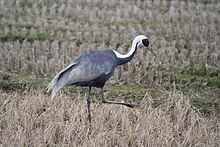July 7, 2016
A new study by WCS (Wildlife Conservation Society) says that breeding populations of white-naped cranes have decreased by 60 percent in Ulz River basin - an important stronghold for the species in Eastern Mongolia.
Survey data from 2000-2001 recorded 42 territorial pairs while the most recent data by WCS documented only 17 pairs.
Eastern Mongolia supports one of the world's most important breeding populations of the white-naped crane, a species classified by the IUCN as "vulnerable," with an estimated total population at 5,500-6,500 individuals. Among the threats to the birds are habitat loss and fire.
Between 2010-2011, WCS visited a 270-kilometer (167-mile) section of the Ulz River basin where (Bradter et al, 2005) surveyed in 2000 and 2001. Additionally, during the same period, WCS extended the survey to more historic crane breeding sites with locations provided by from the Mongolian Academy of Sciences. Those sites are Kherlen River, Onon River catchment and the Khurkh Khuiten Ramsar site.
"Wetland ecosystems across the steppe grasslands of Eastern Mongolia represent critically important breeding habitat for white-naped cranes," said Martin Gilbert, WCS Wildlife Veterinarian. "By revisiting areas surveyed by other researchers ten years earlier, we were able to assess how numbers had changed during a decade of severe drought."
Despite standing over 4 feet tall, the researchers found that the cranes were surprisingly difficult to observe, even in the open habitat of the Mongolian steppe. After observing 234 cranes, the scientists used occupancy modelling to estimate 867-1017 cranes inhabit the survey area, suggesting that Mongolia supports almost half of the world's breeding white-naped cranes.
In the ten years between surveys, using spatial modeling, the scientists noted that an extended drought affected Eastern Mongolia's wetland systems. Additionally, models performed by the scientists indicated that the birds prefer areas of tall wet vegetation and low grazing pressure (to allow for nesting). Several lakes and whole stretches of river that supported cranes in 2001 were completely dry by the 2010 survey, and unsuitable for breeding cranes.

No comments:
Post a Comment